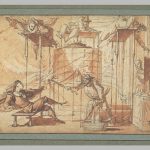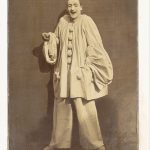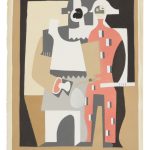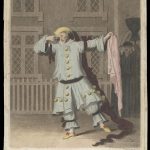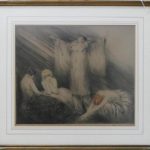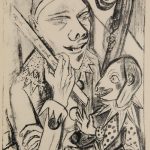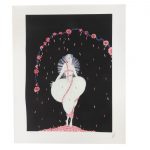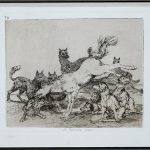Pierrot is a stock character of pantomime and commedia dell’arte whose origins are in the late seventeenth-century Italian troupe of players performing in Paris and known as the Comédie-Italienne, the name is a diminutive of Pierre (Peter), via the suffix -ot. His character in contemporary popular culture—in poetry, fiction, and the visual arts, as well as works for the stage, screen, and concert hall—is that of the sad clown, pining for love of Columbine, who usually breaks his heart and leaves him for Harlequin. Reference: Wikipedia
This is an etching by Huquier which was made with three other studies for the Livre de Scènes Comiques Inventées par Gillot. This drawing shows a scene from Act II of Arlequin, Esprit Follet.
In the middle of a feast, Pierrot at upper right, Pulcinella in the center, and Mezzetino on the left are startled to see the benches they are sitting on shoot into the air. The same device elevates the laden table as well. Scaramouch tumbles over as masked Harlequin threatens him with his torch. On the right, a woman looks back as she leaves. This farce, or “lazzo”, was apparently inspired by a comedy performed at the Théâtre Italien in 1670, Arlequin, Esprit Follet.
Reference
Reference:The Louvre
This is a gelatin-coated salted paper print of Pierrot
The contemporary image of Pierrot is mainly due to the famous mime Jean-Gaspard Baptiste Duburau, who replaced the ruff and wide white hat of the commedia dell’arte character with the long blank face and black skull cap that is recognizable today. Charles Duburau, his son and also a mime, was asked by Nadar and his brother Adrien to pose for a series of “têtes d’expression” that would serve as publicity for the brothers’ struggling studio. The series was an enormous popular success.
This print is after Pablo Picasso and shows an abstract Pierrot with Harlequin.
It was printed around 1920 by Editions Galerie Rosenberg, Paris.
It was sold for 8,750 USD at Sotheby’s
This is a colour full-length portrait engraving of Mr. Delpini in the character of Pierrot in Aladdin. It probably dates to around the late 18th century and shows how the Pierrot looked before the modern Pierrot of the ruffled collar and black cap
Louis Justin Laurent Icart (FRENCH, 1888 – 1950) color lithograph depicting a pierrot with three women. Pencil signed to lower right with embossed seal to lower left, further marked in pencil “Cr.22”. Mounted in a wooden frame with mat behind glass screen.
Sold for $200 at ELITE AUCTIONEERS LLC in 2019
Pierrot and mask. 1920. Lithograph on chamois-colored, smooth copper cardboard. 31 x 20 cm (32.5 x 24.2 cm). Typographically inscribed on the reverse: Max Beckmann: Pierrot and masque. Original lithograph. – Slightly browned along the edges.
Sold for €220 at Jeschke Van Vliet Auctions Berlin GmbH in 2019
